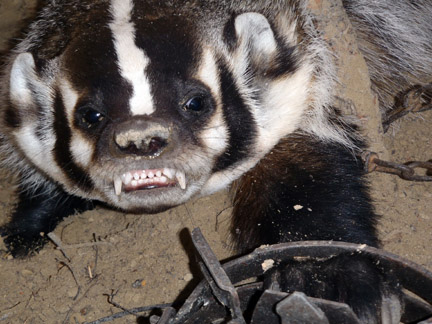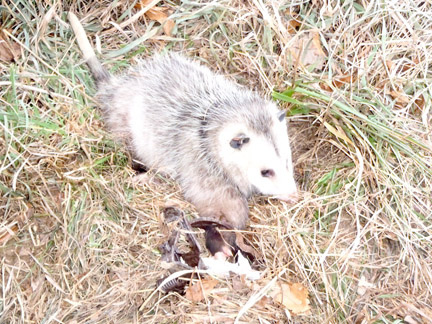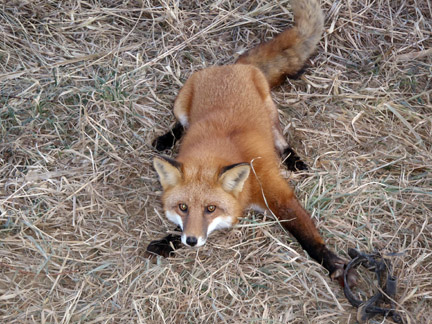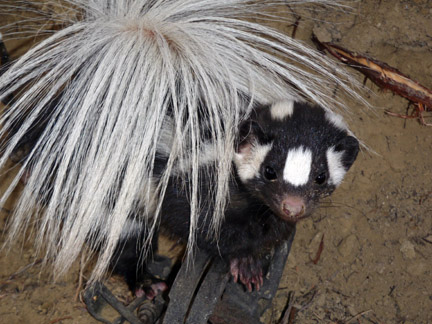



SD Nest Predator Bounty Program
Oppose The SD Nest Predator Bounty Program (NPBP)
Striped Skunks =3,800
Badger = 387
Red Fox = 276
=============
Here is a link – to a November 2023 Newswatch article on this issue titled “South Dakota predator bounty program to continue despite opposition”
https://www.sdnewswatch.org/south-dakota-nest-predator-bounty-program-raccoons-pheasants
=============
FACTS/BACKROUND:
In the fur pelt market as per ” Trapping Today” in 2023/2024
1. the price for most raccoon pelts won’t be as much as $5, unless large pelt, in which case it could bring 5-10 dollars,
2. Red fox pelts are a niche market product and usually average about $10-15
3. Skunks are a traditional novelty market, and should get $10-15..
4. Badger are being harvested in very limited quantities. Badger prices have been strong at around $20 averages, and are expected to stay that way.
5. There was no price offered for opossum pelts.
https://www.trappingtoday.com/2023-2024-fur-prices-trapping-todays-fur-market-forecast/
We assume theses prices are for winter pelts, which are thicker
==============================
JAN 13th, 2023 UPDATE
SD Game, Fish and Parks Commission on Friday, January 13th 2023 approved 4 more years of the Nest Predator Bounty Program at $500,000 per year and $10 per tail. The resolution (23-01) passed unanimously. Here is a link to the resolution: https://phas-wsd.org/wp-content/uploads/RES_23-01_-_2023_to_2026_Nest_Predator_Bounty_Program_Resolution.pdf On Thursday 3 folks testified against the Program – Nancy Hilding for PHAS and Julie Anderson and Jamie Al-Haj. PHAS had a Zoom evening meeting to discuss this and other issues on April 30th, 2023 .
When SD Game, Fish and Parks Commission on January 12th or 13th 2023, it considered the resolution to refund the Nest Predator Bounty Program for 4 years. It was expected that the resolution , would look like the one they passed 2 years ago – funding two years of the program: https://gfp.sd.gov/UserDocs/nav/21-06_Resolution-_Nest_Predator_Bounty_Program_-_2021_and_2022.pdf This approved $500,000 for each year and bounties of $10 per tail. However they surprised us and approved the program for 4 years.
You could have testified against the Program for 3 minutes (or less) during the “Open Forum” (You still can). For instructions on how to testify for the next Commission meeting see our events page).
================================================
DECEMBER 2023 UPDATE
PHAS had a meeting on raccoons & SDGFP management of meso-carnivores 11/29/23 . It discussed the NPBP. It’s recording and other past
PHAS meeting’s recordings are available on our web page on our meeting recordings.
https://phas-wsd.org/recorded-meetings/
November 30th 2023 – A recent article on the Nest Predator Bounty Program occurred in SD News Watch and then the Rapid City Journal and Argus Leader
https://www.sdnewswatch.org/email/90ee94a9-e3c9-4fab-8ffb-8650a04962b8/?ref=sd-news-watch-newsletter
The Game, Fish and Parks Commission will meet December 7th-8th in Fort Pierre & Zoom, You can testify against the Nest Predator Bounty Program
(and anything else) during the open forum at 2 pm CT.
LONGER TERM HISTORY – 4 Previous years
SD Game, Fish and Parks (SDGFP) created a bounty program for nest predators in 2019 and has offered 3 years (2019, 2021 & 2022) of the program – funded at a $500,000 expenditure for bounties at $10 per tail and 1 year (2020) funded with $250,000 in bounties at $5 per tail. The first year SDGFP gave away free traps. Target animals are – raccoons, opossums, striped skunk, red fox, badger. The first year (2019) the live trap give-away program cost $958,171, the payment for tails cost $547,400, salaries/benefits cost $190,915 & miscellaneous expenses cost $35,778 – Thus 2019’s total cost was $1,732,264.
The expenditures are normally approved by the GFP Commission in the first few months of the year and while times of the bounty season have varied – the 2022 bounty ran from March 1 till July 1st. (The first month was for youth). The 2022 Season ended on July 1st and they took 49,778 tails, with raccoons being caught the most, followed by striped skunk and opossums as most caught.
Opossums = 16,700
We oppose this – The NPBP was originally sold as a way to increase pheasant numbers and then also increase other ground nesting birds. As that was not very credible, they added inspiring youth to take up trapping as a program goal. It is ineffective at protecting eggs/nestlings and is cruel. Why do we want to spend at least 3 million dollars over 4 years inspiring children to trap? It is a waste of SDGFP money, that could be better spent on other projects.
One of Kristi Noem’s justifications for Merging DENR into Agriculture Department (creating DANR) was to save about $500,000 a year. She was wasting that annually inspiring kids to trap with a useless & harmful bounty program .
Here is a link to recent (fall 2023) article by SD News Watch on this issue:
OLD ALERT
This page is being written and is evolving. We plan to update, rewrite & move the old alert on the SD Nest Predator Bounty Program (NPBP) that exists on our Blog page. For now our old alert can be found at https://www.blogger.com/blog/post/edit/4368376858740594690/6395956365739341594 but you have to scroll past the otter section to reach the NPBP section.
TAKE ACTION
Tell the SDGFP Commission that you object to the NPBP. Tell the Governor you object (she is a very very strong promoter of it & appoints the Commissioners and hires/fires staff). On our events page we post the dates of upcoming Commission meetings and how to contact the Commissioners. You can get 3 minutes to testify at any Commission meeting. You can write to them. We need people to show up year round and object to the Nest Predator Bounty Program.
Talk to your SD legislators and ask them to change the law and to stop the GFP from funding this wasteful and harmful project. Talk to election candidates about this issue and educate them – ask their position. Ask federal public land managers to make their lands off limits. Educate & organize others about the issue. We hope to create a petition on this issue sometime in spring of 2023. We may create a draft bill to remove funding by legislative act.
You can write to the Commission at any point and/or attend Commission meetings face-to-face or virtual and testify
for 3 minutes.
Because of SDCL 40-36-9, SDGFP can give away free traps, set bounties and allocate money as an administrative action — legislative approval, formal rule making and a public hearing are not required. Ask your legislator to change this law (SDCL 40-36-9) and remove or limit the SDGFP Department’s authority to set bounty programs and decide to spend 1.7 million in just one year on such a wasteful & harmful program.
SDCL 40-36-9. Programs and rules for control of injurious animals–Payment of expenses. The Department of Game, Fish and Parks may direct or employ personnel and conduct programs and the Game, Fish and Parks Commission may adopt pursuant to chapter 1-26 necessary rules to control foxes, coyotes, feral dogs, prairie dogs, and other wild animals. The expense thereof shall be paid out of the Department of Game, Fish and Parks fund or the state animal damage control fund.
Source: SDC 1939, § 25.1004; SL 1974, ch 274, § 2; SL 1978, ch 288, § 5; SL 1983, ch 292, § 10; SL 1984, ch 273, § 36.
———————————————————————————————————–
Reasons to oppose the nest predator bounty program.
–———————————————————————————————————-
WHY OPPOSE?
– Empathetic children may encounter moral dilemmas such as how to kill the 12 or 13 babies in an opossums pouch, and later learn that they did this killing of babies, based on lies told them by SD GFP about effects of a bounty program on nesting success. How does this engage children with nature or give them trust in government?Hantavirus or
Folks put up national petitions four years ago to collect signatures against the program. The introduction to the petitions is dated (4 years old), but the signatures will be presented to the Commission on Thursday 1/12/23.
Past years SDGFP furbearer reports – learn about trapping statistics in our state
https://gfp.sd.gov/UserDocs/nav/-_2018_Furbearer_Annual_Report.pdf – 2018
=============
Visit these links on predator control and pheasants/ducks:
• We refer you to Pheasants Forever’s web page on “Effects of Predators”, https://www.pheasantsforever.org/Habitat/Pheasant-Facts/Effects-of-Predators.aspx
• • Ducks Unlimited’s web page on “Ducks, Habitat Conservation & Predators”
• Also see page 11 of SD GFP’s Pheasant Management Plan, in the section on predators that says: “Where predator control may be considered as a management option, managers should be aware that cost, logistics, and lack of effectiveness often limit success when compared to habitat management. (emphasis added) ”https://gfp.sd.gov/UserDocs/nav/pheasant-mngmnt-planpdf.pdf
=============